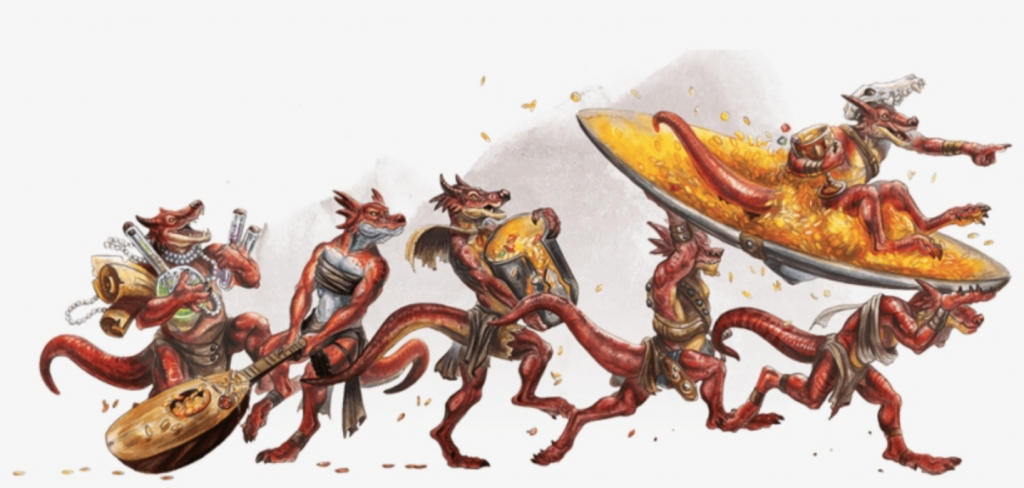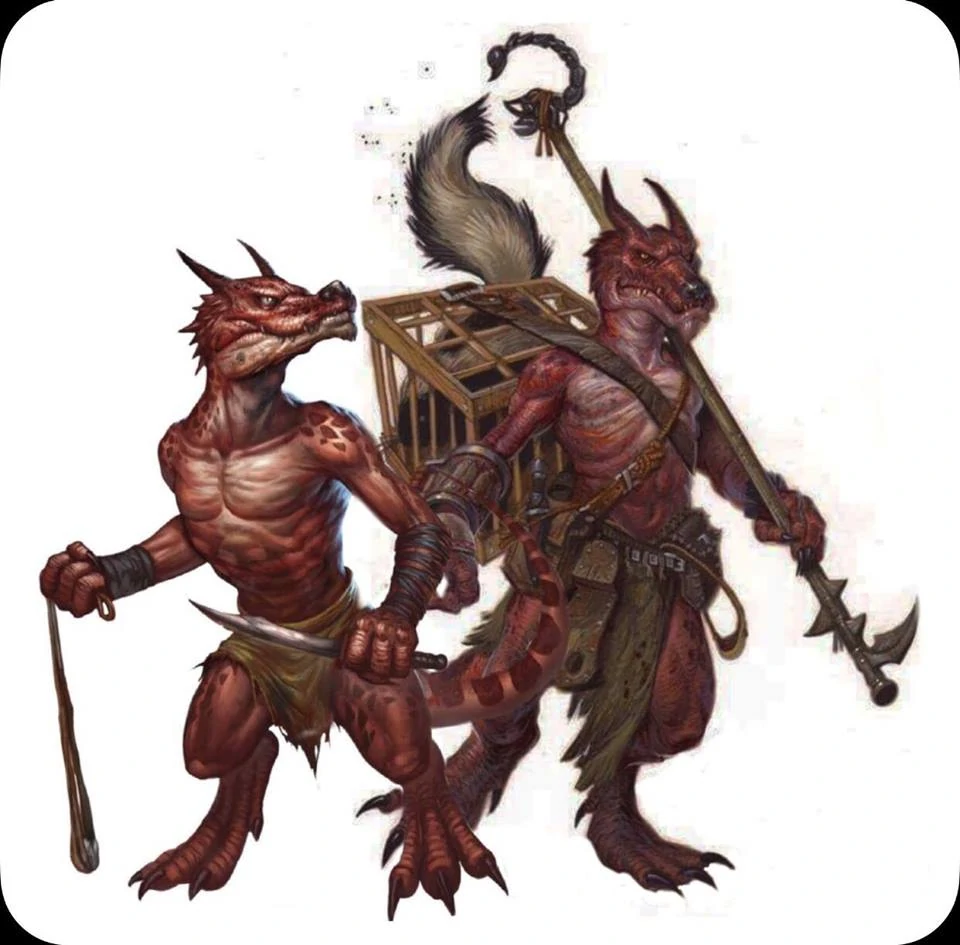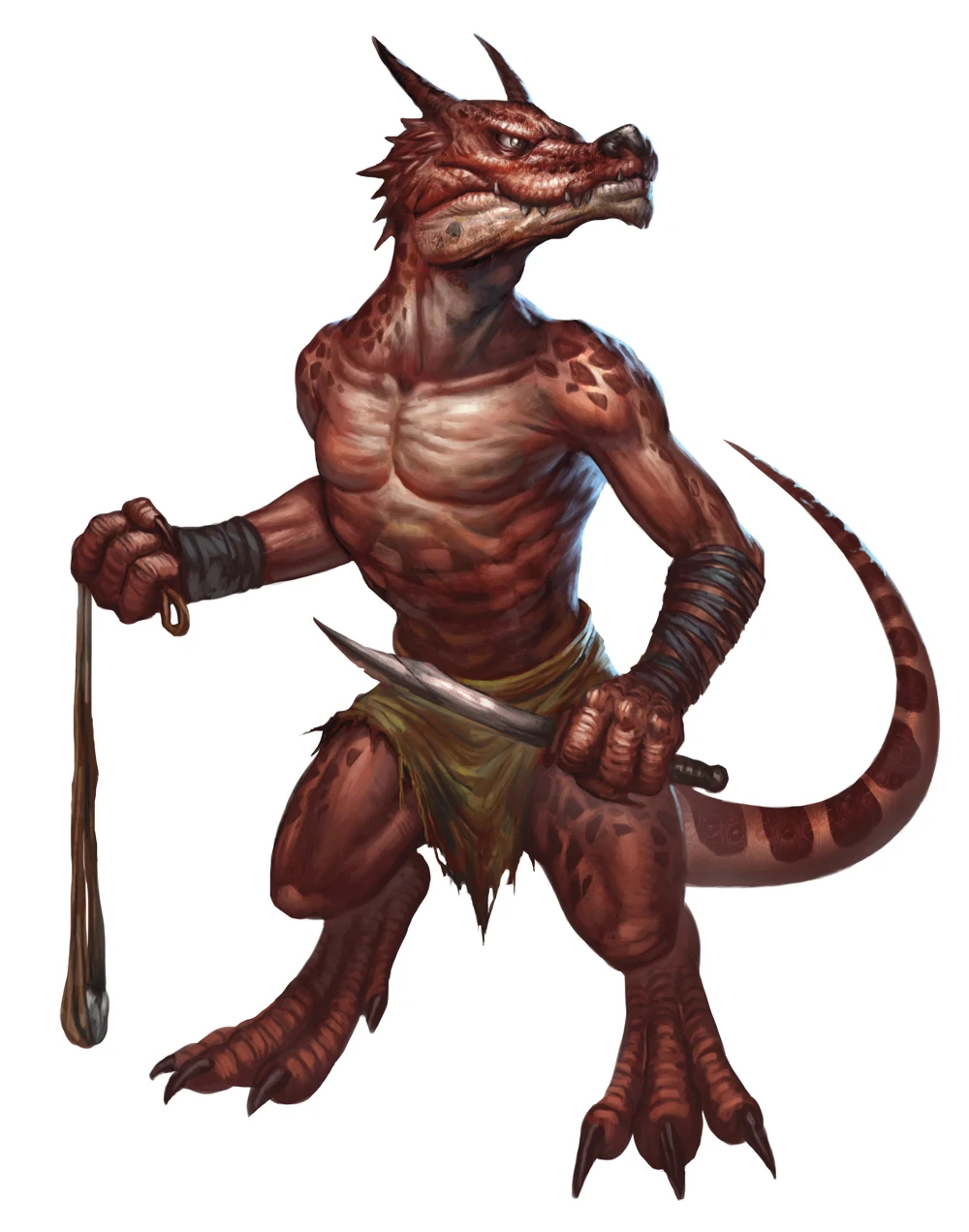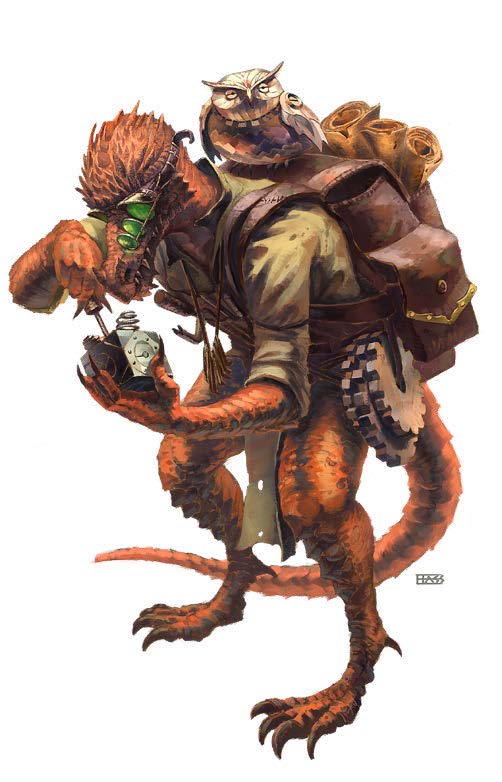Kobold
Shadow Kind
This race originates from the Shadow Realm. However, there are many individuals that have been pulled into the Mundane world. Since they reach adulthood at 6 years old, it is easy for them to establish a new tribe. Thus, there are tribes within the Mundane world that have only individuals that have been born within the Mundane world. These tribes see this world as their home and have no desire to return to a world they were never a part of. It does not take a kobold tribe very long to reach this state since their individuals tend to die before 20 due to their lifestyles.In the Mundane World
In the Mundane world, their tribes are less likely to be ruled by other races. Yet, they are still fearful of invasion and oppression like those within the Shadow Realm. Perhaps this is genetic memory, perhaps it is culturally taught through the generations, but they expect to be ruled by others. They often seek a ruler in order to avoid becoming oppressed by someone that is undesired. Because of this, they are often found to be a helpful sister society to another group of Shadow Kind.Overview
Kobolds are often dismissed as cowardly, foolish, and weak, but these little reptilian creatures actually have a strong social structure that stresses devotion to the tribe, are clever with their hands, and viciously work together in order to overcome their physical limitations. In the kobolds’ version of a perfect world, the creatures would be left alone to dig their tunnels and raise the next generation of kobolds, all the while seeking the magic that will free their imprisoned god. In the world they occupy, kobolds are often bullied and enslaved by larger creatures — or, when they live on their own, they are constantly fearful of invasion and oppression. Although individually they are timid and shy away from conflict, kobolds are dangerous if cornered, vicious when defending their eggs, and notorious for the dangerous improvised traps they use to protect their warrens. Expert Tunnelers Kobolds are naturally skilled at tunneling. They seem to have a near-instinctive sense of what sections of stone or earth are strong or weak, are bearing a load or are safe to excavate, or are likely to contain minerals or offer access to water. This ability enables them to fashion secure homes in places where other creatures wouldn’t feel safe. Kobolds take advantage of their size by creating small-diameter tunnels that they can easily pass through, but that require larger creatures to hunch over or even crawl to make progress. In places where a tunnel opens into a chasm and continues on the other side, the kobolds might connect the two passages with a rope bridge or some other rickety structure, designed to collapse under the weight of any creature heavier than a kobold. On occasion, the route through a kobold lair runs along a ledge that borders a cavern or a crevasse, and the kobolds might erect a railing or a wall that prevents them from falling off the edge — high enough to protect a kobold but low enough to serve as a tripping hazard for a larger creature. Those of other humanoid races have little good to say about kobolds, but they do admit that the little reptilians do respectable tunnel work using simple tools. If a band of kobolds is enslaved by more powerful creatures, the kobolds are usually put to work enlarging their masters’ living area and protecting vital areas of the lair with traps and other defenses. They can also easily be hired by other races to do any required tunneling work such as building sewers. If they are treated well and left alone to do the job, the kobolds work industriously and provide good work. If the kobolds like the area and aren’t mistreated, they might build a warren and make a permanent home there, while continuing to meet the other race's needs. In general, Mundane kobolds are happier living with other races connected to their tribes.Able Scavengers
Kobolds are adept at identifying broken, misplaced, discarded, or leftover crafted items from other creatures that can still be put to use. They prefer to scavenge objects that have clearly been lost or thrown away, which is easy to do without attracting attention. At the same time, they don’t automatically shy away from trying to grab items that are the property of other creatures, because such objects are more likely to be in good condition and thus more useful or valuable. When they go after items that aren’t free for the taking, kobolds try to remain undetected and don’t give their targets reason to harm them. For example, a group of city kobolds might sneak into a cobbler’s house at night to loot it of knives, leather bits, nails, and other useful items, but if they are at risk of discovery, they run away rather than attack anyone in the house. By fleeing before they can be seen or identified, they avoid getting into a situation where the townsfolk would try to hunt down all kobolds and put the tribe’s survival at risk. Some aggressive individual kobolds and tribes do exist, but in general kobolds don’t purposely provoke retaliatory attacks from the creatures they steal from. It’s better to be cautious and overlooked than to be considered dangerous and a threat. In a couple of situations, kobolds might abandon this careful approach. First, because of their hatred of gnomes, city kobolds often go out of their way to target gnomes’ houses and shops. Even in such cases, the kobolds’ fear of retaliation usually prevents them from trying to directly harm the gnomes, but they might spit in the milk, balance dishes on tables so they’re easily knocked over and broken, or scatter sewing needles all over the floor — petty, vengeful acts that humiliate, injure, or anger the gnomes, but not so much that the gnomes want to hunt down and kill the kobolds. Because of the kobolds’ animosity, gnomes tend to avoid or abandon settlements that have a severe infestation of kobolds, and conversely kobolds are usually driven out of communities that have a large gnome population. Second, kobolds are always on the lookout for magic that might help them free their imprisoned god, Kurtulmak. Typical kobolds don’t know how to use a wand, a spell book, or anything with more magical power than a potion, but they all believe that the tribal sorcerer can figure out how to use any such item they come across. When kobolds sense an opportunity to separate a magic item from its owner, they are often willing to take the chance of revealing themselves because the potential reward is worth the risk.Dragon Servitors
Kobolds believe that they were created by Tiamat from the blood of dragons — a view supported by their reptilian (they would say draconic) appearance. In every kobold tribe, the legend of the creatures’ origin is passed down from elder to hatchling, giving each individual and every generation a reason to feel pride and self-respect. The kobolds prefer to run away than fight, to live off the scraps of others, and they are often dominated by larger humanoids, but they know that there is greatness within them and they are proud that they were chosen to be the blood-kin of dragons. Kobolds willingly serve chromatic dragons and worship them as if they were demigods — mighty beings of divine descent. This isn’t a casual sort of worship or lip service; kobolds are awed in the presence of a dragon, as if an actual avatar of a deity were in their presence. Kobolds fall all over themselves to obey orders from a dragon, even if they are dangerous orders. Although kobolds usually don’t worship Tiamat directly, they recognize her as the dragon-goddess of all chromatic dragons, and as the master of their racial god, Kurtulmak.Arcane Magic Users
Unlike some other humanoids, kobolds don’t fear or shun arcane magic. They see magic as part of their connection to dragons, and are proud to be blessed with the ability to wield such power. Young kobold sorcerers are trained by elders, and the training has an almost religious significance. Most kobold sorcerers are of the draconic bloodline origin and specialize in either damaging magic (which can also be used in mining), augmentation (of materials or allies), or divination (to find raw materials and foresee threats to the tribe). The main reason why kobolds depend on arcane magic rather than divine is Kurtulmak’s imprisonment, which makes it difficult for him to grant spells to mortals and for those mortals to receive his favor. Furthermore, kobolds are so frail that a single hit from a human’s weapon can kill one of them, so a tribe has little use for healing magic, and a sorcerer can meet most of the tribe’s other magic-related needs. Kobold shamans are very rare; priests of Kurtulmak, when they reveal themselves, are easily recognized by orange garb (usually just a roughly torn sash or cloak) decorated with an image of a gnome’s skull.Life and Outlook
Kobolds have a tribal society in which they all take on specialized roles that protect and sustain the tribe. The strongest kobolds are trained to be hunters and warriors, the most clever are crafters and strategists, the toughest are miners and beast-wranglers, and so on. Even a stupid or physically weak kobold is given a role in the tribe, whether something as simple as picking mushrooms for food or watching over hatchlings, and they all understand that their actions contribute to the survival of the group. The tribe practices for the eventuality of defending the lair against intruders, and their plans always include knowing the best escape routes and who is responsible for blocking tunnels to deter pursuit. Kobolds feel a cool affinity or something like kinship for other members of their tribe, but they are rarely affectionate with each other. Two kobolds who’ve known each other for over a decade might consider each other friends or enemies, but the strength of this sentiment is much fainter than any comparable human emotion. Since most of their waking time is spent working, adversarial kobolds rarely have opportunities to exchange insults, let alone come to blows over their differences. Kobolds choose mates primarily for convenience. Their lack of emotional bonding means they have no concept of marriage or permanent family relationships. Their eggs are placed in a common tribal hatchery with no effort to keep track of who each one’s mother is. This practice and the communal raising of the hatchlings mean that the tribe operates like a group of cousins. Because they lay eggs, and the eggs don’t require much tending, kobold females aren’t exempted from war or work. Furthermore, kobolds can slowly change sex. If most males or females of a tribe are killed, some survivors change over several months until the tribe is balanced again. In this way, the tribe can quickly repopulate with just a few survivors. Because of these factors, kobolds don’t have assigned gender roles for young or adults. A leader, sorcerer, miner, or crafter is as likely to be female as male.Grow Fast, Die Early
Kobolds grow and mature much more swiftly than members of other humanoid races. At 6 years old a kobold is considered an adult. Most succumb to violence, accidents, or disease by age 20, but a kobold can live for up to 120 years — a longevity they attribute to being distantly related to dragons. A female can lay up to six eggs per year, and an egg matures for two to three months before it hatches. Kobolds don’t engage in funeral ceremonies; a dead kobold’s body is burned or disposed of in some other convenient way (or, in a cannibalistic tribe, eaten). Kobolds believe that if they die in service to their tribe, Kurtulmak immediately sends each of them back to life as the next egg laid in the hatchery. If a particularly important or respected member of a tribe dies, the hatchery is closely monitored. The next egg laid is immediately separated from the rest and carefully protected. Once it hatches, the resultant young kobold is groomed to fill a position of importance.Basic Information
Anatomy
URDS: WINGED KOBOLDS
Winged kobolds, known as urds, hatch seemingly at random from kobold eggs, even in a tribe that has no adult urds. Although being able to fly is an incredible gift, and it would be expected for kobolds to interpret the wings as a blessing from Tiamat, ordinary kobolds resent urds and don’t get along with them. Fragments of kobold legends speak of Kuraulyek, a winged godling servant of Kurtulmak, who betrayed his master in some way. Kobolds see urds as Kuraulyek’s favorites, and they project their resentment of this traitor onto their winged kin.Dietary Needs and Habits
Although their sharp teeth would suggest they are carnivores, kobolds are actually omnivores, and can eat just about anything, including meat, fruit, tree bark, bone, leather, and eggshells (a newly hatched kobold’s first meal is usually its own shell). A hungry tribe leaves nothing behind from a kill, eating everything that’s edible and using the rest to make tools or adornments. Kobolds shed teeth as they wear out and grow new ones their entire lives. Many wear their own shed teeth as jewelry, with more teeth indicating an older — and wiser — kobold. Some unscrupulous individuals wear teeth stolen or harvested from others in an attempt to make them seem older and more respectable.
Most kobold tribes avoid eating what they call “talking meat” — intelligent creatures — because such behavior prompts retaliation. The fear of starvation can make them flexible about this principle, however, and if their options are either attacking such creatures or going hungry, kobolds are practical. A few tribes, particularly those in lightly populated areas, practice cannibalism, believing it is foolish to waste good meat.
In any case, kobolds that eat humanoids don’t simply start consuming corpses or prisoners right after a battle; they’re more inclined to tie their victims to saplings and slowly roast them over a fire, or put them in a giant cook pot to make stew. Fortunately for the prisoners, the kobolds’ almost comedic preparations sometimes give rescuers time to locate and free the captives before the kobolds settle down for the main course.







Comments